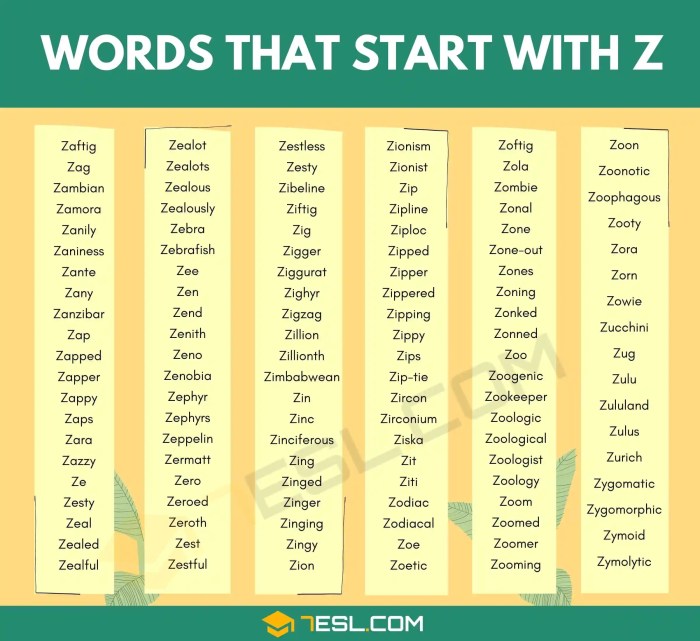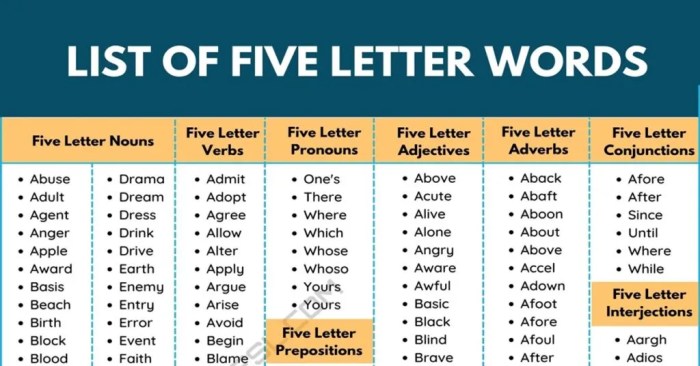5 Letter Words: Exploring the Versatile Building Blocks of Language
5 Letter Words are the fundamental units of language, providing a rich tapestry of expression and communication. From everyday speech to literary masterpieces, these words play a pivotal role in shaping our thoughts and connecting us with the world around us.
General Overview of 5 Letter Words
In the vast expanse of the English language, 5 letter words form an essential building block, providing a foundation for countless expressions and ideas. Defined as words composed of exactly five letters, they exhibit distinct characteristics that contribute to their prevalence and versatility in everyday communication.
The frequency of 5 letter words in the English language is a testament to their ubiquitous nature. Studies have consistently shown that they constitute a significant proportion of written and spoken English, appearing in various forms, from common nouns and verbs to adjectives and adverbs.
Examples of Common 5 Letter Words
The diversity of 5 letter words is evident in the wide range of examples that encompass everyday objects, actions, and concepts. Some of the most frequently used 5 letter words include:
- Words denoting objects: apple, chair, table, book
- Words describing actions: jump, run, sing, play
- Words expressing qualities: happy, sad, big, small
li>Words representing concepts: love, hope, peace, joy
Linguistic Analysis of 5 Letter Words

The linguistic analysis of 5 letter words delves into the phonetic, phonological, and morphological patterns that characterize these words. This analysis provides insights into the sound structure, syllable structure, and word formation processes involved in 5 letter words.
Phonetic and Phonological Patterns, 5 Letter Words
Phonetically, 5 letter words exhibit a wide range of sound combinations. The most common consonant sounds in 5 letter words include /t/, /n/, /s/, /r/, and /l/. Vowels, on the other hand, are more evenly distributed, with /a/, /e/, /i/, /o/, and /u/ all appearing frequently.
As we delve into the realm of five-letter words, let’s not overlook the captivating Red Sparrow Cast . Their stellar performances in the thrilling espionage film left an unforgettable mark on the silver screen. But returning to our word game, five-letter words offer endless possibilities, inviting us to explore the depths of language and communication.
Phonologically, 5 letter words often follow specific syllable structure patterns. The most common syllable structure is CV (consonant-vowel), followed by CVC (consonant-vowel-consonant) and CCVC (consonant-consonant-vowel-consonant). These patterns contribute to the rhythm and flow of 5 letter words.
Letter Combinations and Vowel Sequences
Certain letter combinations and vowel sequences are particularly common in 5 letter words. For example, the letter combination “th” is frequently found in words like “that,” “this,” and “them.” Vowel sequences such as “ai” (as in “rain”) and “ee” (as in “feet”) are also prevalent.
The frequency of these letter combinations and vowel sequences is influenced by factors such as the language’s phonological system, the frequency of certain sounds in the language, and historical sound changes.
Morphological Structure
Morphologically, 5 letter words can be analyzed in terms of their prefixes, suffixes, and root words. Prefixes are morphemes that are added to the beginning of a word, such as “un-” (as in “unhappy”) or “re-” (as in “return”). Suffixes are morphemes that are added to the end of a word, such as “-ed” (as in “walked”) or “-ing” (as in “walking”).
Root words are the core meaning-bearing elements of words. They can be combined with prefixes and suffixes to form new words with different meanings. For example, the root word “walk” can be combined with the prefix “re-” to form “re-walk” or with the suffix “-ing” to form “walking.”
The morphological structure of 5 letter words reveals the intricate ways in which words are built up from smaller meaningful units. This analysis provides insights into the word formation processes of the language and the relationships between words.
Cognitive and Educational Aspects of 5 Letter Words
5 letter words play a crucial role in language acquisition and reading development. Their manageable length and frequent occurrence make them accessible to young learners, fostering literacy skills and vocabulary expansion.
In educational settings, 5 letter words are commonly used in spelling games, vocabulary building exercises, and phonics instruction. By engaging with these words, students develop phonemic awareness, letter recognition, and spelling proficiency.
Teaching and Learning Strategies
- Phonics Instruction:Introduce 5 letter words with simple phonics patterns (e.g., CVC words like “cat”) and gradually increase complexity.
- Spelling Games:Engage students in interactive spelling games, such as word searches, crosswords, and hangman, to reinforce 5 letter word recognition and spelling.
- Vocabulary Building Exercises:Encourage students to explore the meanings and usage of 5 letter words through word lists, dictionaries, and context-based activities.
Cultural and Literary Significance of 5 Letter Words

Five-letter words hold a unique place in the tapestry of human expression. Their brevity and versatility have made them a cornerstone of languages, literature, and popular culture across the globe.
Diving into the world of 5 Letter Words, we find a vast ocean of possibilities. Just as the Blue Whale Restaurant serves up a tantalizing array of culinary delights, so too do 5 Letter Words offer a feast of linguistic wonders.
From “apple” to “zebra,” these five-lettered gems unlock doors to endless possibilities, enriching our vocabulary and expanding our expressive range.
Use in Literature
In literature, 5 letter words serve as building blocks for evocative imagery, succinct storytelling, and memorable phrases. From Shakespeare’s “To be or not to be” to Hemingway’s “For sale: baby shoes, never worn,” these words pack a punch that belies their size.
Did you know that there are numerous 5-letter words that describe the meteorological event of Groundhog Day? Check out Groundhog Day Streaming Australia for more information on this intriguing holiday. And while you’re at it, don’t forget to expand your vocabulary with some fascinating 5-letter words related to this special day.
Influence on Popular Culture
Beyond literature, 5 letter words have permeated popular culture. Word games like Scrabble and Wordle have made them a source of entertainment and mental agility. They have also become synonymous with puzzles, riddles, and other mind-bending challenges.
Applications of 5 Letter Words in Technology

5 letter words play a significant role in various technological applications, particularly in the fields of natural language processing, machine learning, data analysis, text mining, and information retrieval.
In natural language processing, 5 letter words are used to build language models, which are statistical representations of language. These models help computers understand the structure and meaning of text, enabling applications such as machine translation, text summarization, and sentiment analysis.
Data Analysis and Text Mining
In data analysis and text mining, 5 letter words are used for feature extraction. By analyzing the frequency and distribution of 5 letter words in a dataset, researchers can identify patterns and trends that may not be apparent from the raw data.
This information can be used for tasks such as text classification, spam filtering, and fraud detection.
Concluding Remarks
In conclusion, 5 Letter Words are not merely linguistic curiosities but essential elements that underpin our ability to communicate, learn, and create. Their versatility and ubiquity make them indispensable tools for expression, understanding, and innovation.
Question Bank
What are the most common 5 Letter Words?
Some of the most common 5 Letter Words include ‘the’, ‘and’, ‘that’, ‘have’, and ‘with’.
How many 5 Letter Words are there in the English language?
There are approximately 20,000 5 Letter Words in the English language.
What are some strategies for teaching 5 Letter Words effectively?
Effective strategies include using flashcards, playing word games, and incorporating 5 Letter Words into reading and writing exercises.